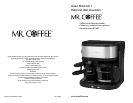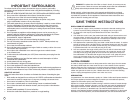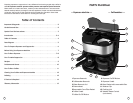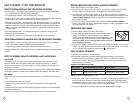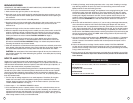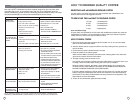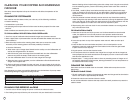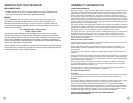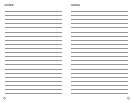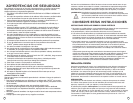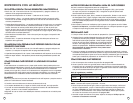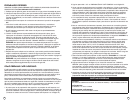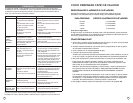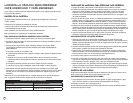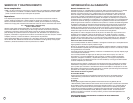
12 13
CLEANING YOUR COFFEE AND ESPRESSO
MACHINE
Over time, mineral deposits built-up in this machine will affect the operation of the
appliance.
CLEANING THE COFFEEMAKER
Your machine must be cleaned when you notice any of the following conditions:
reservoir
These conditions are caused by lime or other mineral deposits.
TO CLEAN MINERAL DEPOSITS FROM YOUR COFFEEMAKER
1. Pour four cups of undiluted white household vinegar into the water reservoir.
2. Place a paper filter or permanent filter into the removable filter basket and close the
brew basket lid.
3. Place the empty carafe on the warming plate. Make sure to center the carafe
accurately on the warming plate to avoid the possibility of overflow.
a. Press the ON button.
b. When three cups of vinegar have flowed into the carafe, turn the Coffeemaker off
and let the vinegar stand for 30 minutes.
c. After 30 minutes, pour the vinegar from the carafe back into the coffeemaker
reservoir and place the empty carafe back on the warming plate.
d. Turn the coffeemaker back on to let all of the vinegar flow through.
e. When the brew cycle is complete, turn the coffeemaker off and discard both the
vinegar and the paper filter.
4. To flush out all traces of vinegar from the unit, brew 10 cups of water in the unit. Do
not use coffee grounds but DO use a filter in the brew basket. Repeat the process as
necessary.
How frequently you clean your machine depends upon the hardness of your tap water.
The following table gives suggested cleaning intervals.
SUGGESTED CLEANING INTERVAL
Type of Water Cleaning Frequency
Soft Water (Filtered Water) Every 80 Brew Cycles
Hard Water (Tap Water) Every 40 Brew Cycles
CLEANING YOUR ESPRESSO MACHINE
1. Turn the unit to Off and unplug the power cord from the electrical outlet.
2. The frothing tube may still be hot, do not touch it with your hands until it has cooled.
Remove frothing aid and wipe frothing tube with a damp cloth. Using the wrench built
into the measuring spoon, unscrew the frothing aid and clean valve with a needle or
toothpick.
3. The carafe , carafe lid, filter, brew basket and drip tray can be washed with soapy
water or placed on the top rack only of your dishwasher. CAUTION: Do not immerse
appliance in water. Do not remove reservoir cap or brew basket while appliance is
under pressure.
4. After the pressure has been released, remove reservoir cap. Discard the remaining
water through the top opening of the water reservoir by turning the appliance upside
down over the sink. Always empty the water reservoir of any water between uses. Do
not immerse appliance in water. Screw the reservoir cap back in place.
5. Wipe housing with a soft wet cloth. Do not use abrasive cleaners or scouring pads as
they will scratch the finish.
TO DELIME INTERNAL PARTS
1. Make sure all controls are OFF, the power cord is disconnected from the electrical
outlet, the appliance is cool and all pressure in the espresso machine has been
released. Pour 10 ounces of fresh undiluted white household vinegar into the water
reservoir.
2. Screw the cap back on top of the espresso water reservoir. Make sure the cap is
on tight.
4. Insert the filter into the brew basket and place it in its locked position on the
appliance. Center the carafe under the brew basket nozzle. Insert the glass carafe
in place with lid on the drip tray.
5. Plug the power cord into the electrical outlet.
6. Turn the power switch on and allow the vinegar flow to begin until all the vinegar has
been pumped into the carafe and the flow has stopped, turn the control knob to Off
and allow the appliance to cool.
the machine. Repeat this rinsing process, allowing the machine to cool and pressure to
be released before each rinsing.
CLEANING THE CARAFES
Hard water can leave a whitish stain on the carafe. Coffee and tea may then turn the
stain brown.
TO REMOVE CARAFE STAINS:
1. Fill each carafe with a solution of equal parts tap water and vinegar and let the solution
stand in the carafe for approximately 20 minutes.
2. Discard the solution and wash and rinse the carafe.
Do not use harsh abrasive cleansers that may scratch the carafe; scratches may cause the
carafe to break.



